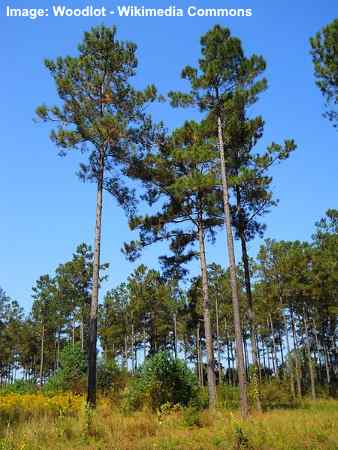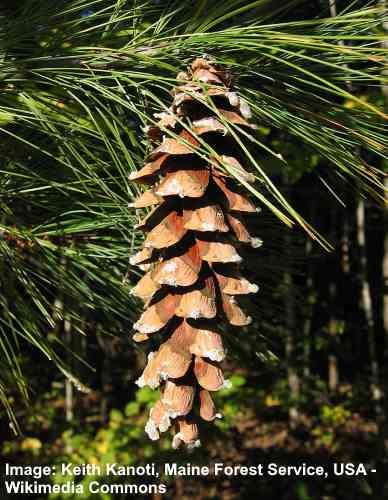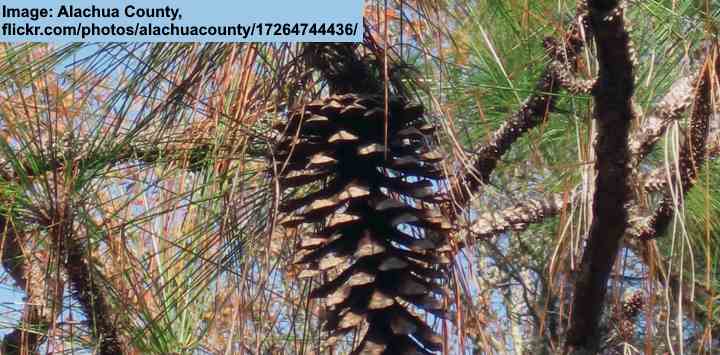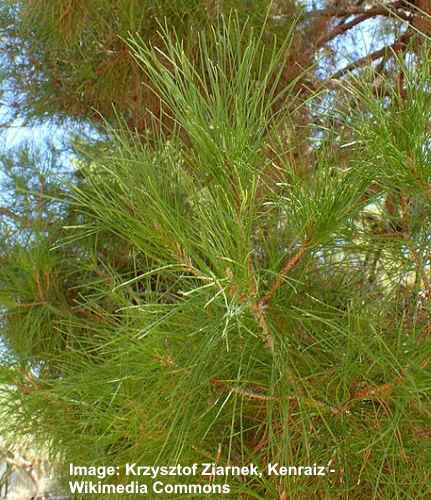Types of Pine Trees in Texas (With Pictures) – Identification Guide

Texas is home to several species of native pine trees. From the common loblolly pine and shortleaf pine to the dwarf mugo pine, these majestic coniferous trees thrive in Texas. Although pine trees are cold-hardy conifers, many species of these evergreen trees thrive in the hot, dry, and sometimes humid climate of Texas.
Texas pine trees perform well throughout the largest state in the United States. From the arid climate in the west of Texas to the warm, subtropical conditions in Central and East Texas, pine trees are an important part of the landscape.
Which are the best pine trees for growing in the Lone Star State? This article examines the most popular species of pine trees in Texas, including their characteristics, growth rate, and general appearance. Knowing about their features will help you identify pine trees in Texas landscapes.
Texas Pine Trees Facts
Several species of pine trees, including the loblolly, shortleaf, and ponderosa pines, thrive in Texas. These coniferous evergreen trees are cone-bearing plants in the genus Pinus. The fast-growing softwood trees have needle-like leaves, egg-shaped seed-containing cones, and reddish-brown bark.
Texas pine trees grow in various regions throughout the state. For example, east Texas has sandy soils and a wetter climate, ideal conditions for growing loblolly, shortleaf, and longleaf pines. On the other hand, in west Texas, the dry, arid climate is ideal for pine trees like the pinyon and ponderosa pines.
The loblolly pine tree is the most common pine tree species in Texas. The coniferous evergreens are prevalent in forests in the eastern part of the state, east of Abilene to the Louisiana border. Loblolly pines are important for timber and landscaping in the southern US.
The tallest pine trees in Texas are the loblolly and shortleaf pines. The loblolly pine (Pinus taeda) is a fast-growing evergreen that can reach heights of 100 to 120 ft. (30 – 36 m). On the other hand, the shortleaf pine (Pinus echinata) grows 65 to 150 ft. (20 – 45 m) tall.
Both tree species are native to Texas and thrive in the hot, humid climate of east Texas.
Texas Pine Tree Needles
Texas pine tree needles are slender and grow in bundles (called fascicles) of two or three. Typically dark green needles on Texas pines grow 3” to 10” (7.5 – 25 cm) long. However, the native longleaf pine needles are 10” to 18” (25 – 45 cm) long.
Pine needles on Texas trees can be bluish-green, dark green, or silvery green. They also have a strong pine scent and a pungent resinous flavor. The needles remain on the tree year-round, making the Texas pine an evergreen coniferous tree.
Texas Pine Tree Cones
Texas pine tree cones are identified by their egg, conical, or cylindrical shape and light brown woody scales. Depending on the pine species, the cones can measure between 1.5” and 12” (4 – 30 cm) long. Texas pine cones typically take two years to mature. Many contain edible seeds—pine nuts, which are also an important food source for wildlife.
Texas Pine Tree Bark
The bark of Texas pine trees varies between species. However, it is generally reddish-brown and forms thick plates and deep ridges as the tree matures. A characteristic growth habit of pine trees is how the branches are arranged in whorls around the trunk.
However, it’s good to note that the bark isn’t the best way to identify pine trees in Texas. This is because many species of trees have similar bark texture and color. The bark within a particular species can also differ depending on the growing conditions.
How to Identify Texas Pine Trees
Identifying a pine tree in Texas requires looking at the needles, cones, bark, and overall shape of the tree. Pine tree needles grow in bunches of two or three. Next, check the cones. The shape of the scaly ovoid structures is typically unique to the pine species.
Lastly, look at the tree’s shape to help identify the Texas pine. The crowning foliage of some pines, like the loblolly and shortleaf pines, are near the top of the tree. However, pinyon and ponderosa pine branches are closer to the ground.
By combining all these factors—needles, cones, bark, and overall shape—you should be able to tell the difference between different species of pine trees in Texas.
Types of Pine Trees in Texas (With Pictures) – Identification Guide
Pine trees are a common and beautiful sight in Texas landscapes. Here is a guide to help you identify some of the most common pine tree types in Texas.
Loblolly Pine Tree (Pinus taeda)

The tall Loblolly pines are very common in south-east USA
The loblolly pine tree is the most widespread pine tree in Texas. The slender pine is identified by its pyramidal to oval crown on top of a slender, erect dark reddish-brown trunk. The bark forms thick, grayish, flaky plates separated by deep grooves. The majestic pines in Texas grow up to 125 ft. (38 m) tall.

Loblolly pine bark
Loblolly pines are native to eastern Texas and thrive in USDA zones 6 to 9. The Lost Pines Forest near Bastrop and along the Colorado River are popular places to observe Loblolly pines in Texas. Loblolly pines are also native to Florida.
The loblolly pine is one of the most easily recognizable pines in a Texan landscape.

Loblolly pine needles
Texas pine tree needles: Loblolly needles measure 5” to 10” (13 — 25 cm) and grow in bundles of three. The needles are yellowish-green to dark green.
Texas pine tree cones: Loblolly reddish-brown cones have a conical shape and measure 3” to 5” (7.5 – 13 cm) long. They are covered in sharp prickles.

Loblolly pine needles and female cones
Shortleaf Pine (Pinus echinata)

Shortleaf pines are common in eastern Texas and reach tall height
The shortleaf pine is a common Texas pine tree that grows around 100 ft. (30 m) tall. Common in eastern Texas, the evergreen conifer is identified by its conical to rounded crown that opens with age. The pine tree has long, slender needles, small egg-shaped cones, and relatively thin, scaly bark that is brownish-red.
Classed as a southern yellow pine, the shortleaf pine is a hardy tree that thrives in USDA zones 6 through 9 and can grow in a variety of soil types. The pine tree is commonly found in the southeastern United States and is an important source of lumber and pulpwood.

Shortleaf pine needles, male cones (left) and female cone (right)
Texas pine tree needles: Shortleaf pine needles are long and slender, measuring 3” to 5” (7.5 – 13 cm) long and growing in clusters of two in a fascicle.
Texas pine tree cones: Shortleaf pine cones are the smallest of all the native Texas pine trees. The small and ovoid cones measure 1.5” to 2.5” (4 – 6 cm) in length. The cones grow in clusters and are covered in shape prickles.
Eastern White Pine (Pinus strobus)

You can find the cold hardy and fast growing eastern white pine in north Texas
The eastern white pine is an evergreen tree in north Texas and thrives in regions north of Austin. The elegant pine tree grows 50 to 80 ft. (15 – 24 m) tall. It is characterized by a spreading, conical crown, long slender cones, and dense foliage. As the eastern white pine matures, the bark turns reddish-brown with scaly patches and long furrows.
Eastern white pines are cold-hardy pines thriving in USDA zones 3 through 8. They are adaptable to a range of soil types, including well-drained sandy soil. The pine tree is also known for its fast growth rate, making it an excellent choice for landscaping projects.
Texas pine tree needles: Eastern white pine needles are soft and flexible, growing in bundles of five and measuring 3” to 5” (7.5 – 13 cm) long.
Texas pine tree cones: Eastern white pine cones are slender and conical, measuring 4” to 8” (10 – 20 cm) long. Their ornamental appeal means they are often used in crafts and decorations.

Eastern white pine cone
Ponderosa Pine (Pinus ponderosa)

The tall Ponderosa pine is important in the timber industry and is common in northeastern Texas
The Ponderosa pine is a native conifer to the southwestern United States and a common pine growing in Texas. The impressive evergreen conifer has a pyramidal growth habit, spreading branches, and distinctive red-brown bark. It produces yellowish-green needles that emit a citrusy aroma. The Ponderosa pine has dark brown bark with deep fissures.
An identifying feature of the ponderosa pine is its vanilla scent when scratching the bark. Its timber is important in the lumber industry because of its strength and fine grain.
Ponderosa pines require full sun growing in USDA zones 3 to 7. This means the large, long-lived pine only survives in northeastern Texas, especially in the Davis Mountain Range. The tall pine grows 60 to 100 ft. (18 – 30 m) tall.

Ponderosa pine needles and cones
Texas pine tree needles: Ponderosa pine needles are dark green or yellowish green, relatively thick, and flexible. They measure 3” to 6” (7.6 – 15 cm) long, grow in bundles of three, and give off a resinous scent.
Texas pine tree cones: Ponderosa pine cones are large, grayish-brown fruits measuring 3” to 6” (7.5 – 15 cm) long. The cones have thick scales with recurved spikes at the tips.
Slash Pine (Pinus elliottii)

Slash pine has long needles and is native to southeastern USA
The slash pine is a tall, slender pine tree growing in eastern Texas. The coniferous tree has a straight trunk and a conical crown, which becomes irregular as the tree matures. Slash pines are usually 100 ft. (30 m) tall with a trunk diameter of 3 ft. (1 m). The pine tree’s bark is thick, with reddish or orange-brown plates.
Slash pines are common in east Texas and feature in urban areas from Dallas to Houston. Its rapid growth makes it a popular pine tree for reforestation in Texas and the southeastern United States.

Slash pine needles and a cone
Texas pine tree needles: Slash pine needles are dark green grow 5” to 10” (10 – 20 cm) long in bundles of two or three. The needles are arranged in a spiral, giving them a bottlebrush appearance.
Texas pine tree cones: The slash pine cones are light brown and slender, measuring 4” to 6” (10 – 15 cm) long. The scales are thin and prickly and are slightly curved outward.
Pinyon Pine (Pinus edulis)

The small Pinyon pine has short needles that grow in pairs and can be found in west Texas
Pinyon pines are small coniferous trees that thrive in the arid conditions of west Texas. The desert pine trees are identified by their bushy, rounded crown and small, yellowish-green pairs of stiff needles, slender cones, and light brown bark with scaly ridges.
Pinyon pines thrive in USDA zones 7 through 9 and are well-suited for growing in hot, dry climates. The Texas pine trees grow 10 to 20 ft. (3 – 6 m) tall. Pinyon pines are common in Sierra Diablo and the Guadalupe mountains.

Pinyon pine cones
Texas pine tree needles: Pinyon pine needles are short and stiff, measuring up to 1.5” (4 cm) long.
Texas pine tree cones: Pinyon pine cones are small, round, and reddish-brown, measuring around 1” to 1.5” (2.5 – 4 cm) in diameter. The cones grow in clusters of two or three and contain edible seeds.
Longleaf Pine (Pinus palustris)

Longleaf pines are native to Texas and are identified by long needles and trunks
The longleaf pine is a majestic pine tree native to Texas. As its name suggests, the identifying characteristic of the pine is its long needles that grow up to 18” (45 cm) in length. Additionally, longleaf pines have large, narrow pyramidal cones and red-brown bark and grow up to 125 ft. (38 m) tall.
The longleaf pine is a slow-growing tree that thrives in well-drained soils and full sun. It is often found growing in forests in East Texas and thrives in dry, sandy ground.

Longleaf pine needles and immature cones
Texas pine tree needles: Longleaf pine needles are long, thin, and playable, measuring 6” to 18” (15 – 45 cm) in length. The needles grow in bundles of two or three and are bluish-green.
Texas pine tree cones: Longleaf pine cones are large conical seed-bearing structures with thick scales. Longleaf cones are some of the largest among Texas pine trees, measuring 6” to 15” long (15 – 38 cm) long.

Longleaf pine cone
Texas Pinyon Pine (Pinus remota)

Texas pinyon pine is native to southwestern Texas and is relatively small
The Texas pinyon pine is a small to medium-sized evergreen conifer native to southwestern Texas. The pine tree is identified by its thick, scaly bark, slender, dull-gray needle leaves, and globular cones. The shrubby pine trees grow 10 to 35 ft. (3 – 10 m) tall.
The Texas pinyon pine is a hardy tree that tolerates a range of soil types and weather conditions. It grows best in USDA zones 7 and 8. Also called the papershell pine, this native pine tree is common in the mountains and high deserts of Texas, New Mexico, and Arizona. The pine tree tolerates heat and drought, ideal for growing in arid Texas landscapes.
Texas pine tree needles: Texas pinyon pine needles are short, slender, and blue-green. The pine needles measure about 1” to 2” (2.5 – 5 cm) long and grow in bundles of two.
Texas pine tree cones: Texas pinyon pine cones are squatly round and have a yellow-brown buff color. The small cones measure up to 2” (5 cm) in length and contain edible nuts.
Dwarf Mugo Pine (Pinus mugo var. pumilio)

Pinus mugo ‘Pumilio’ is a small evergreen pine shrub that can be used as a ground cover for sunny areas
The dwarf mugo pine is a small, slow-growing evergreen shrubby conifer, ideal for small garden landscapes in Texas. This compact pine tree is identified by its low, open habit, dense branches, and dark gray bark. Its low growth and tolerance to heat make it a popular landscaping plant in Texas.
This dwarf mugo pine tree thrives in USDA zones 3 through 9 and is adaptable to a wide range of soil types. The dwarf mugo pine typically reaches a height of 3 to 6 ft. (1 – 2 m) and a width of 4 to 8 ft. (1.5 – 2.5 m). It’s ideal for landscaping southern gardens as a foundation plant, accent conifer, container plant, or border plant.
Texas pine tree needles: The dwarf mugo pine has dark green needles that grow in pairs and are short, measuring 1” (2.5 cm) long.
Texas pine tree cones: Mugo pine tree cones are small and round, measuring only about 2.5” to 5.5” (2.5 cm) long. They have a nut-brown color and a woody texture.
Eldarica Pine (Pinus eldarica)

Eldarica pine is non-native to Texas but is suitable for its climate
Also known as the Afghan pine, the Eldarica pine is a non-native conifer naturalized in many parts of Texas. The medium-sized pine tree has a short, straight trunk and a conical crown. It has dense foliage consisting of slender needles and long, brown woody cones.
The Eldarica pine is well-suited to the Texan climate, thriving in USDA zones 6 through 8. The tree prefers full sun and well-drained soil. It can grow up to 40 ft. (12 m) tall. In Central and West Texas landscapes, the conifer works well as a windbreak, evergreen privacy hedge, or natural screen.

Eldarica pine needles
Texas pine tree needles: The Eldarica pine has slender, medium green needles measuring 3” to 5” (7.5 – 13 cm) long. The wiry needle leaves grow in bundles of two and have a soft feel.
Texas pine tree cones: The Eldarica pine tree produces woody, egg-shaped cones that grow 3” (7.5 cm) long. The cones are initially green but turn brown as they mature.
Related articles:
